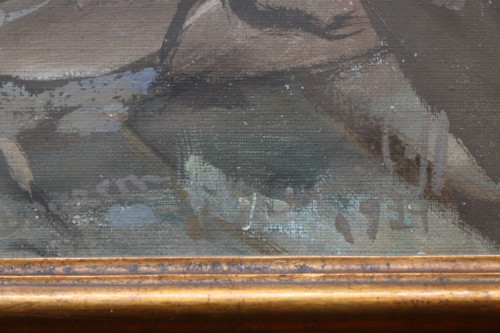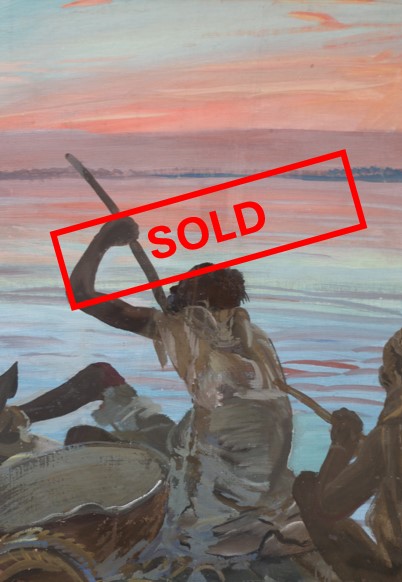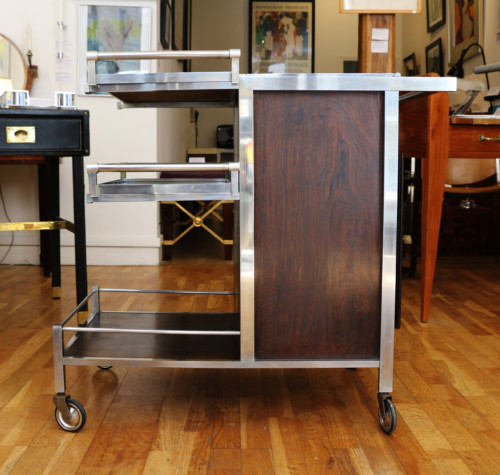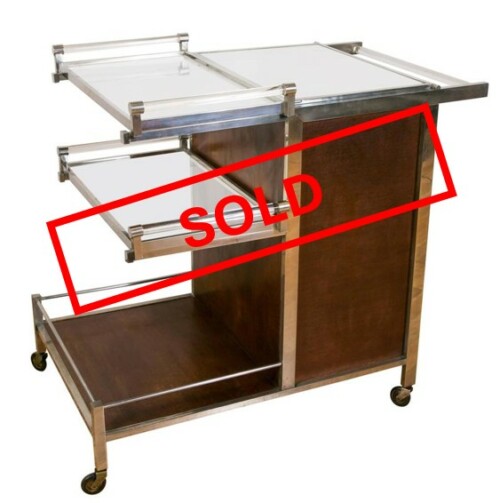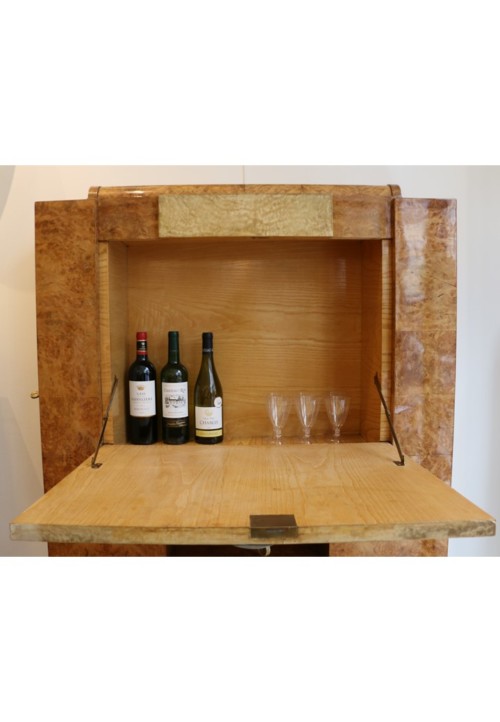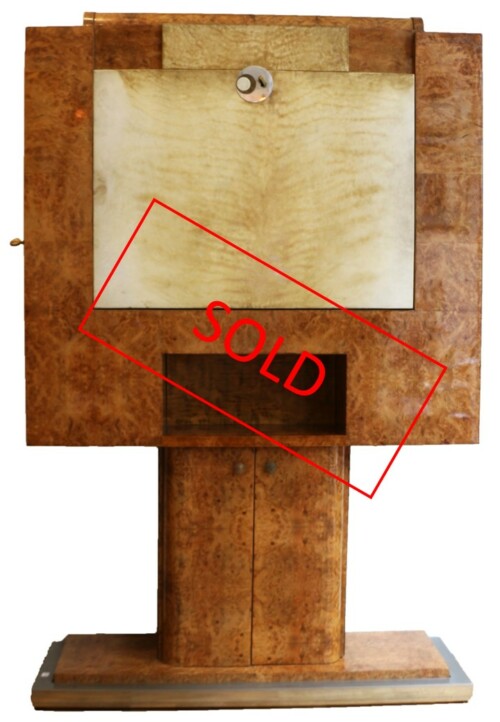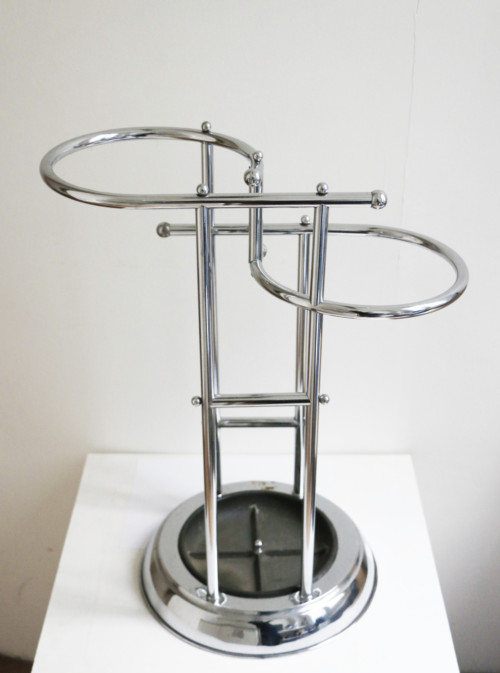Alexander IAKOVLEV (1887-1938)
La Pirogue
Technique mixte sur toile sur carton
Peinte durant la Croisière Noire, à Bourem village malien sur le fleuve Niger
Signée et datée 1927
Dimensions : H : 64 cm ; L : 46 cm
Certificat d'Elena Iacovleva spécialiste de Iakovlev
Pour plus d'informations sur le créateur, cliquer sur son nom : Alexander Iakovlev
Oil on canvas "The Pirogue" by Alexander Iakovlev (1887-1938)
Mixed canvas technique on carboard
Painting during the Black Cruise, in Bourem a malian village on the Noger river
Signed and dated of the year 27
Dimensions :
H : 25.5 in ; W : 25.5 in
H : 64 cm ; W : 18.12 cm
For more information : Alexander Iakovlev
-
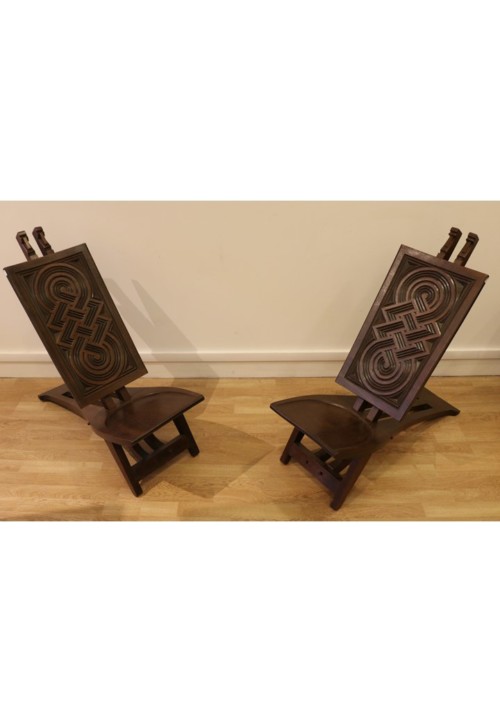
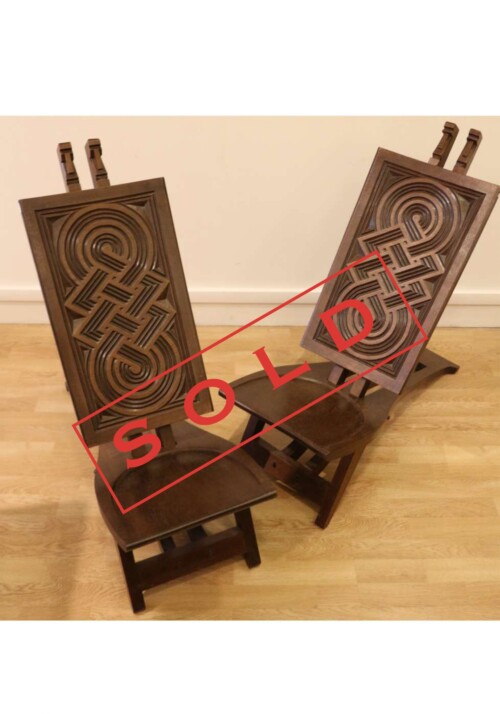 TRES RARE PAIRE DE CHAISES « africanistes » en bois exotique. Elles reposent sur des pieds réunis par une entretoise avec assise légèrement évidée. Le dossier est sculpté de motifs géométriques et de deux têtes simulées de type Dogon. Epoque ART DECO. Provenance : Exposition coloniale de 1931. Bibliographie : « Magazine VOGUE, suite très privée dans un palace New Yorkais un appartement Art Déco signé François CATROUX » pour quatre sièges de forme identique à dossiers avec variantes. Ces chaises rescapées de l’Exposition coloniale de 1931, ont été redécouvertes par Marc AMOURIC. Ces modèles s’inspirent des chaises à palabre ou chaises de gardien africaines. H : 82 cm; H d'assise : 26 cm ; L : 36 cm ; P : 94 cm.
TRES RARE PAIRE DE CHAISES « africanistes » en bois exotique. Elles reposent sur des pieds réunis par une entretoise avec assise légèrement évidée. Le dossier est sculpté de motifs géométriques et de deux têtes simulées de type Dogon. Epoque ART DECO. Provenance : Exposition coloniale de 1931. Bibliographie : « Magazine VOGUE, suite très privée dans un palace New Yorkais un appartement Art Déco signé François CATROUX » pour quatre sièges de forme identique à dossiers avec variantes. Ces chaises rescapées de l’Exposition coloniale de 1931, ont été redécouvertes par Marc AMOURIC. Ces modèles s’inspirent des chaises à palabre ou chaises de gardien africaines. H : 82 cm; H d'assise : 26 cm ; L : 36 cm ; P : 94 cm.
Very rare pair of "Africanist" chairs in exotic wood. The back is carved with a tribal geometric design and 2 heads in Dogon style. Art Deco period. They have been exhibited at the famous Paris Colonial Exhibition in 1931. Biography : «VOGUE Magazine , private suite in a New York palace: an Art Deco flat decorated by François CATROUX » for 4 chairs with identical shape and similar style chairback. These chairs, which survived the Paris Colonial Exhibition in 1931, have been rediscovered by Marc AMOURIC. These chairs are inspired by the "Tribal Palaver Chairs" or "African Guardian Chairs". -
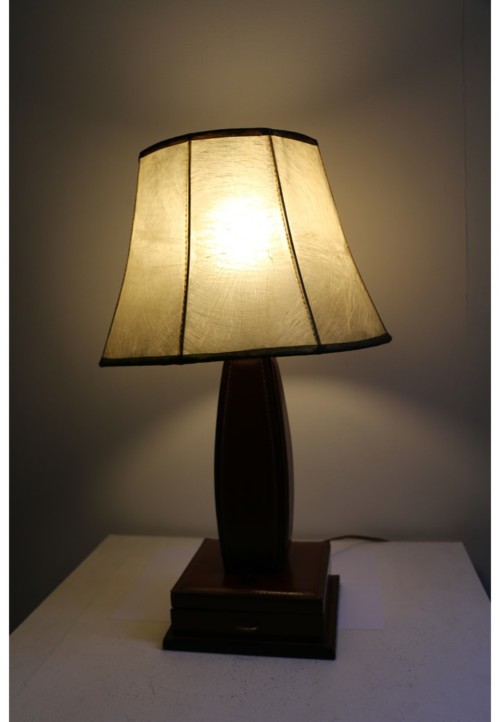
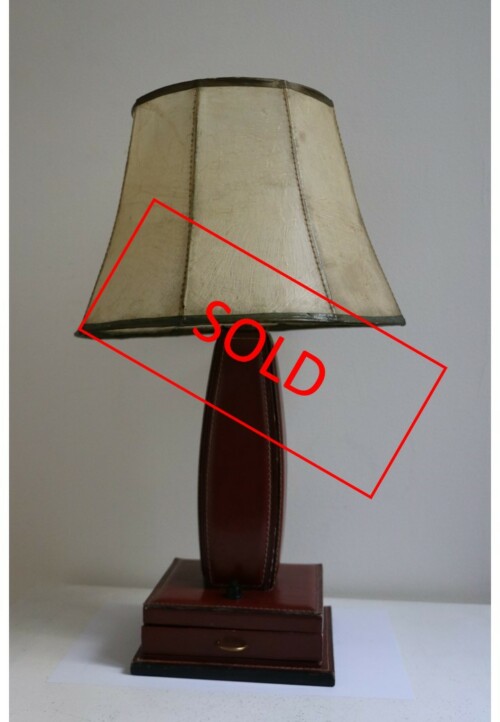 Jacques ADNET (1900-1984) Lampe de table à structure en bois, gainée de cuir rouge à piqûres sellier, à base carrée ouvrant sur un petit tiroir à poignée en laiton doré, abat-jour d’origine en fibre de verre projeté sur armature métal Années 50 Pied : H : 33 cm ; L : 17 cm ; P : 17 cm Abat-jour : H : 21 cm ; D : 30 cm Hauteur totale : 50 cm Pour plus d’informations sur le créateur, cliquer sur le nom : Jacques ADNET
Jacques ADNET (1900-1984) Lampe de table à structure en bois, gainée de cuir rouge à piqûres sellier, à base carrée ouvrant sur un petit tiroir à poignée en laiton doré, abat-jour d’origine en fibre de verre projeté sur armature métal Années 50 Pied : H : 33 cm ; L : 17 cm ; P : 17 cm Abat-jour : H : 21 cm ; D : 30 cm Hauteur totale : 50 cm Pour plus d’informations sur le créateur, cliquer sur le nom : Jacques ADNET -
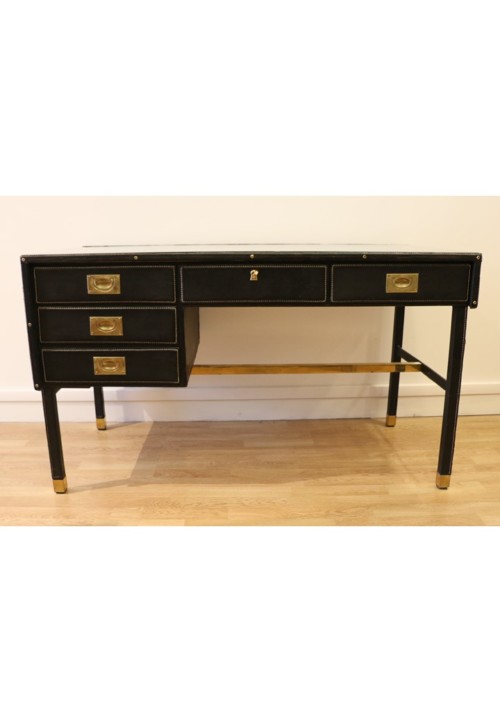
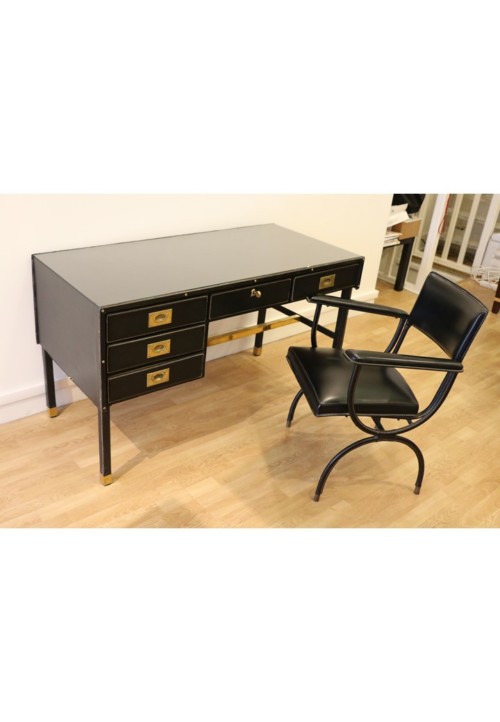 Jacques ADNET (1900-1984) Bureau et son fauteuil Recouverts skaï et cuir piqué sellier. Poignées bateau et sabots en laiton Années 50 H : 77,5 cm ; L : 131 cm ; P : 61,5 cm Pour plus d’informations sur le créateur, cliquer sur le nom : Jacques ADNET
Jacques ADNET (1900-1984) Bureau et son fauteuil Recouverts skaï et cuir piqué sellier. Poignées bateau et sabots en laiton Années 50 H : 77,5 cm ; L : 131 cm ; P : 61,5 cm Pour plus d’informations sur le créateur, cliquer sur le nom : Jacques ADNET
Desk and armchair Covered in skai and saddle-stitched leather. Boat handles and brass shoes. 1950's H: 77.5 cm; W: 131 cm; D: 61.5 cm For more informations : : Jacques ADNET -
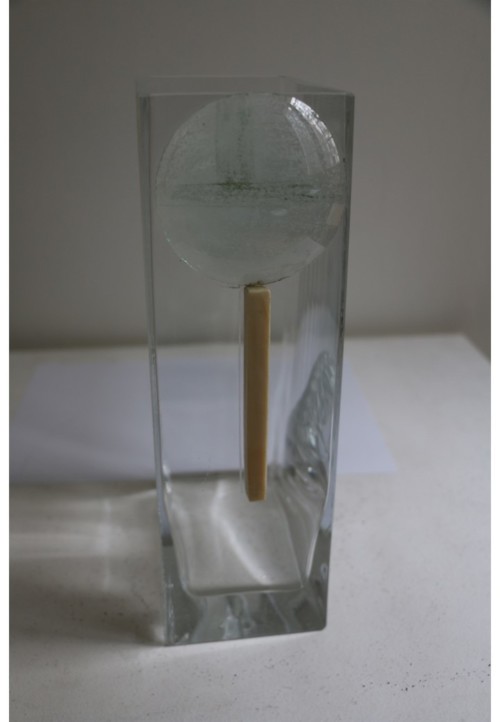
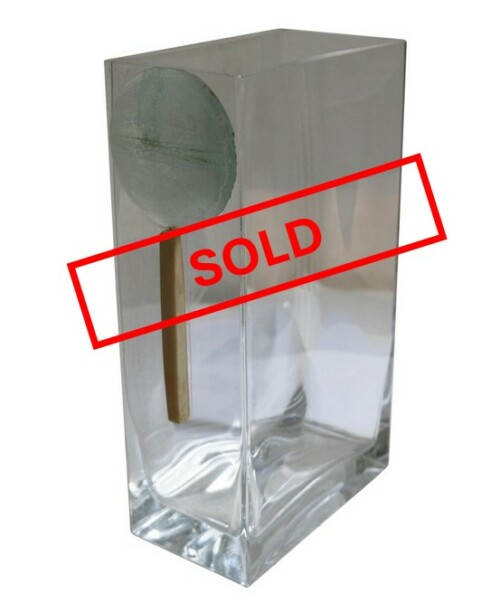 A. Riecke — Vase Art-Déco Vase Art-Déco gravé d’un décor cubisant. Signé et daté 4.8.39. H : 27 cm ; L : 15 cm ; P : 8,5 cm A. Riecke, artiste russe, installé à Paris a été responsable du décor en verrerie Art Déco de 1930 à 1937 du restaurant La Coupole à Paris. Le Restaurant La Coupole est le temple de l’Art Déco. Il naît en 1927 de la volonté de deux Auvergnats, Ernest Fraux et René Lafon. Le soir de l’inauguration, tout le monde des Arts, des Lettres, de la nuit est là : des artistes et leurs modèles, des mondains et des flambeurs.
A. Riecke — Vase Art-Déco Vase Art-Déco gravé d’un décor cubisant. Signé et daté 4.8.39. H : 27 cm ; L : 15 cm ; P : 8,5 cm A. Riecke, artiste russe, installé à Paris a été responsable du décor en verrerie Art Déco de 1930 à 1937 du restaurant La Coupole à Paris. Le Restaurant La Coupole est le temple de l’Art Déco. Il naît en 1927 de la volonté de deux Auvergnats, Ernest Fraux et René Lafon. Le soir de l’inauguration, tout le monde des Arts, des Lettres, de la nuit est là : des artistes et leurs modèles, des mondains et des flambeurs. -
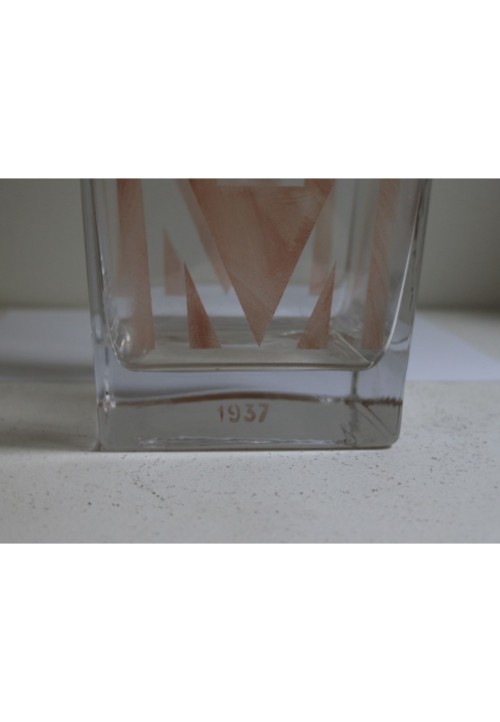
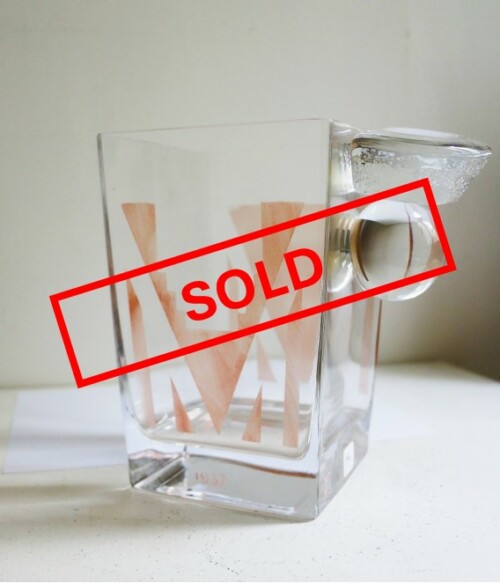 A. Riecke — Vase Art-Déco Vase Art-Déco gravé d’un décor cubisant et daté 1937. Provenance : restaurant La Coupole à Paris. H : 20 cm ; L : 20 cm ; P : 13 cm A. Riecke, artiste russe, installé à Paris a été responsable du décor en verrerie Art Déco de 1930 à 1937 du restaurant La Coupole à Paris. Le Restaurant La Coupole est le temple de l’Art Déco. Il naît en 1927 de la volonté de deux Auvergnats, Ernest Fraux et René Lafon. Le soir de l’inauguration, tout le monde des Arts, des Lettres, de la nuit est là : des artistes et leurs modèles, des mondains et des flambeurs.
A. Riecke — Vase Art-Déco Vase Art-Déco gravé d’un décor cubisant et daté 1937. Provenance : restaurant La Coupole à Paris. H : 20 cm ; L : 20 cm ; P : 13 cm A. Riecke, artiste russe, installé à Paris a été responsable du décor en verrerie Art Déco de 1930 à 1937 du restaurant La Coupole à Paris. Le Restaurant La Coupole est le temple de l’Art Déco. Il naît en 1927 de la volonté de deux Auvergnats, Ernest Fraux et René Lafon. Le soir de l’inauguration, tout le monde des Arts, des Lettres, de la nuit est là : des artistes et leurs modèles, des mondains et des flambeurs. -
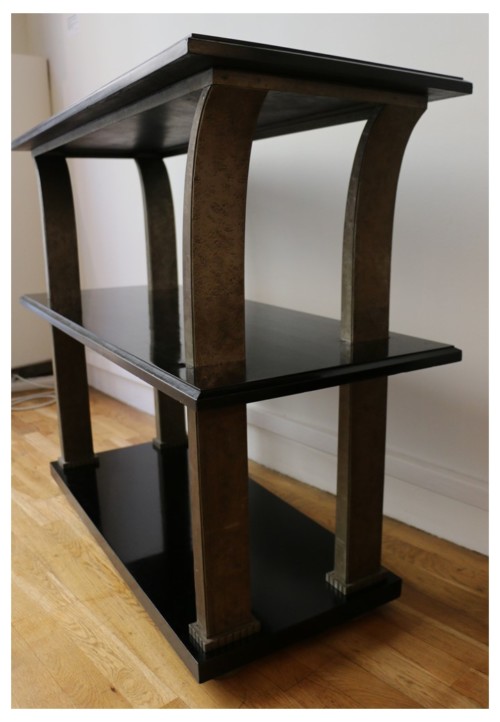
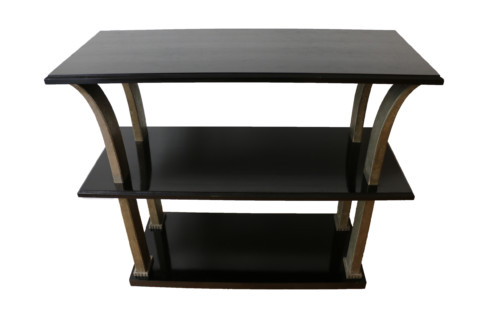 Edgar BRANDT(1880-1960) Console à trois plateaux rectangulaires en bois relaqué noir. Piétement d'angle à quatre jambes quadrangulaires fuselées en métal à corps stylisant des palmes, bagues rainurées en partie basse. Cette console est symétrique, ne nécessite pas d'être adossée contre un mur et peut être utilisée comme table de milieu. Frappé de l'estampille sur un des pieds. Années 1920 H : 90 cm ; L : 108 cm ; Profondeur : 45 cm Pour plus d’informations sur le créateur, cliquer sur le nom : Edgar BRANDT
Edgar BRANDT(1880-1960) Console à trois plateaux rectangulaires en bois relaqué noir. Piétement d'angle à quatre jambes quadrangulaires fuselées en métal à corps stylisant des palmes, bagues rainurées en partie basse. Cette console est symétrique, ne nécessite pas d'être adossée contre un mur et peut être utilisée comme table de milieu. Frappé de l'estampille sur un des pieds. Années 1920 H : 90 cm ; L : 108 cm ; Profondeur : 45 cm Pour plus d’informations sur le créateur, cliquer sur le nom : Edgar BRANDT
Stunning Metal and Wood Console by Edgar Brandt, Art Deco, France, 1920'sConsole with 3 shelves/trays by Edgar BRANDT(1880-1960). The shelves are made of black relacquered wood. The 4 squared legs are made of hammered metal in a palm shape. Stamped on a leg: "E. Brandt". France, 1920's Dimensions: H : 90 cm ; W : 108 cm ; D : 45 cm The console is fully symetrical so it does not need to be put against a wall and can be displayed in the middle of a room as a center table.For more informations : Edgar BRANDT -
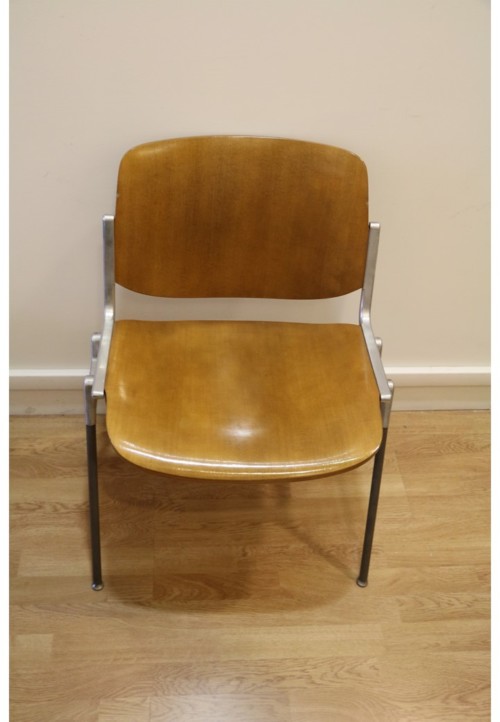
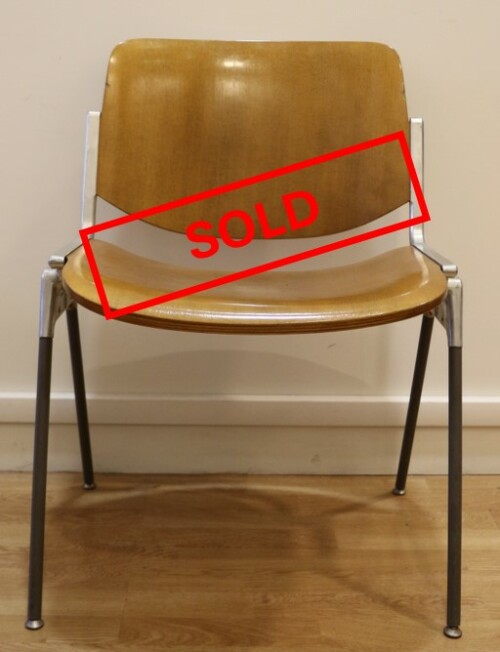 Giancarlo PIRETTI (1940-…) Edition Castelli. Suite de 6 chaises, modèle 106 dessiné en 1967. Assise et dossier en contreplaqué moulé, piètement quadripode tubulaire, gainé avec sabots. Plus édité. Couleur miel clair H : 77 cm ; H d'assise : 48 cm ; L : 56 cm ; P : 48 cm Pour plus d’informations sur le créateur, cliquer sur le nom : Giancarlo PIRETTI
Giancarlo PIRETTI (1940-…) Edition Castelli. Suite de 6 chaises, modèle 106 dessiné en 1967. Assise et dossier en contreplaqué moulé, piètement quadripode tubulaire, gainé avec sabots. Plus édité. Couleur miel clair H : 77 cm ; H d'assise : 48 cm ; L : 56 cm ; P : 48 cm Pour plus d’informations sur le créateur, cliquer sur le nom : Giancarlo PIRETTI
Set of Six Mid-Century Modern Chairs by Giancarlo Piretti, Italy, 1970s. Set of six chairs by Giancarlo Piretti, Model Nr 106 designed in 1967, Italy, Castelli edition. This model is no longer manufactured. Chair back and chair seat made of thermoformed/molded plywood. Veneer has been restored, Very nice light honey color. Legs and frame made of steel and aluminium. These chairs are very comfortable and can be stacked. Another set of two identical chairs is available with a slightly darker veneer. Measures: H 77 cm; Seating H 48 cm; L 56 cm; P 48 cm. For more informations : Giancarlo PIRETTI -
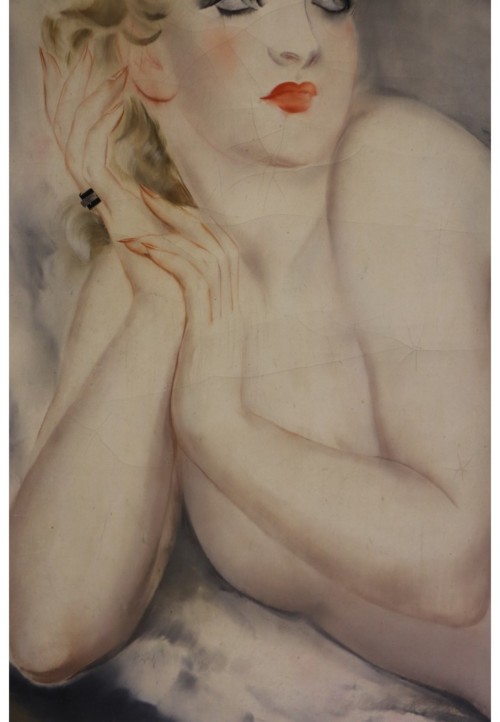
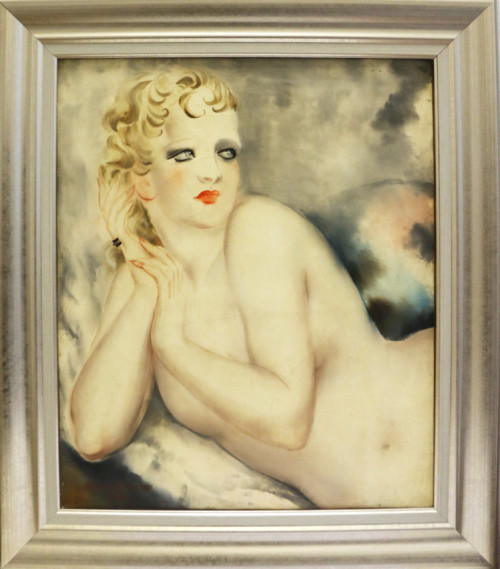 Miçao Kono était un artiste japonais arrivé à Paris au début des années 1920. Il peignait à l'huile et à l'aquarelle, et réalisa également plusieurs gravures. Miçao Kono a devenu célèbre pour ses portraits de nus combinant le style traditionnel japonais à la modernité de l'Art Déco. Ses peintures étaient très populaires dans les intérieurs Art Déco. Romantiques et sensuelles, ses œuvres sont proches de celles de son compatriote japonais Foujita. La technique de Kono était inhabituelle, car il mélangeait le blanc d'œuf avec les pigments de couleur. Soit par intention, soit avec le temps, ses peintures présentent des signes de craquelures.
Miçao Kono était un artiste japonais arrivé à Paris au début des années 1920. Il peignait à l'huile et à l'aquarelle, et réalisa également plusieurs gravures. Miçao Kono a devenu célèbre pour ses portraits de nus combinant le style traditionnel japonais à la modernité de l'Art Déco. Ses peintures étaient très populaires dans les intérieurs Art Déco. Romantiques et sensuelles, ses œuvres sont proches de celles de son compatriote japonais Foujita. La technique de Kono était inhabituelle, car il mélangeait le blanc d'œuf avec les pigments de couleur. Soit par intention, soit avec le temps, ses peintures présentent des signes de craquelures.- Huile sur papier marouflé sur toile.
- Signé et daté 19 (33) en rouge en bas à gauche.
Miçao Kono was a Japanese artist who came to Paris in the early 1920s. He painted in oils and watercolors, and also did a number of etchings. Micao Kono became famous with his nude portraits combining traditional Japanese style with the modernity of the Art Deco. His paintings were very popular in the Art Deco interiors. They were romantic and sensuous; his work is close to his Japanese fellow countryman Foujita. Kono’s technique was unusual as he used to mix egg white with color pigment. Either by design or by the passage of time his paintings show signs of cracking.- Oil on paper pasted on canvas.
- Signed and dated 19 (33) in red at bottom left.
